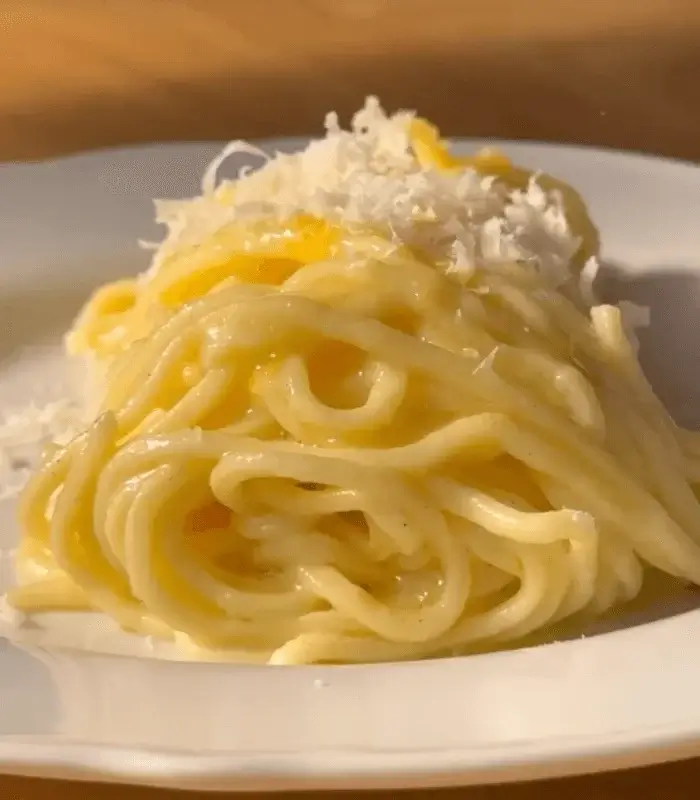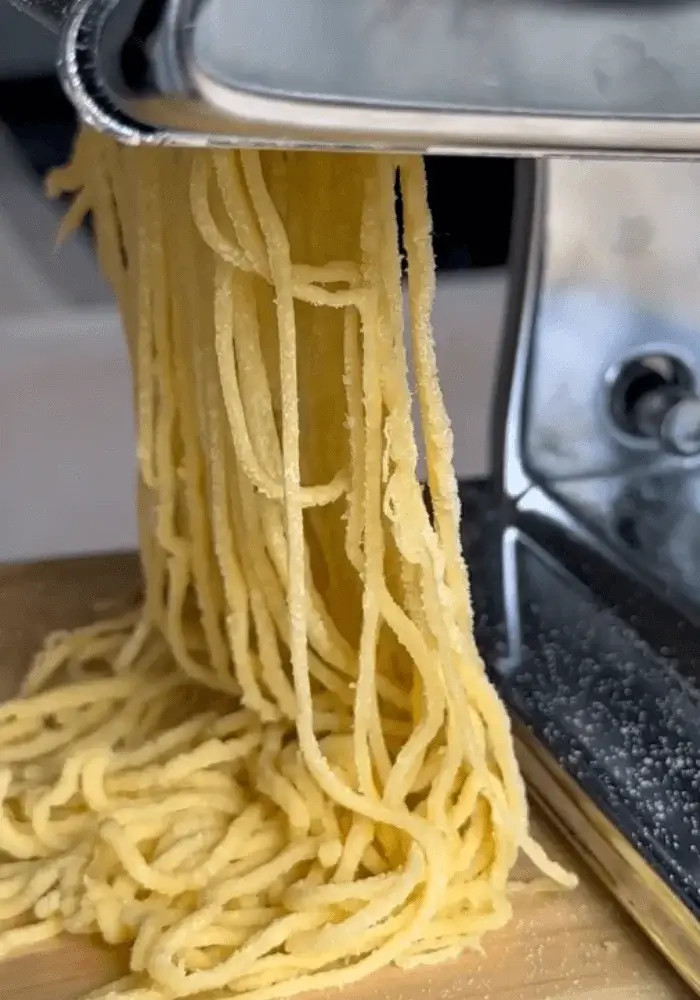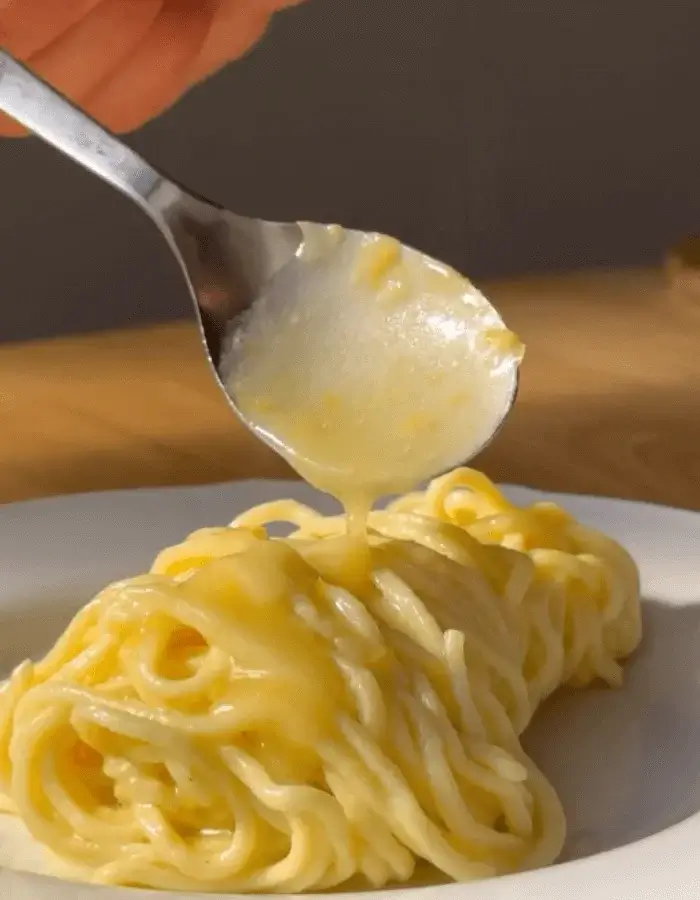Lemon Butter Pasta with Fresh Semolina Noodles
We may earn a commission from recommended products, at no extra cost to you. See Disclosure.
- Rolling Pin
- Large pot
- Colander
INGREDIENTS
Pasta:
- 1¾ cups/250 grams semolina flour
- 1 teaspoon fine sea salt
- 3 large eggs
- ½ teaspoon olive oil
Sauce:
- ½ cup reserved pasta cooking water, as needed
- 2 tablespoons unsalted butter, preferably Président
- 2 tablespoons Parmesan cheese, finely grated
- Juice of 1 lemon
- Zest of 1 lemon
- Salt, to taste
INSTRUCTIONS
- In a large mixing bowl, whisk together the semolina flour and salt. Pour the flour onto a clean work surface (such as a large cutting board or countertop) and form it into a mound. Use the base of a bowl to press a deep well into the center.
- Crack the eggs into the well and beat lightly with a fork. Slowly incorporate the flour into the eggs, starting from the center and working your way outward. Add the olive oil as you mix, until a shaggy dough begins to come together.
- Knead the dough by hand on the surface for 7 to 10 minutes, until smooth and elastic. Wrap tightly in plastic wrap and refrigerate for 30 minutes.
- Dust your work surface and the rested dough lightly with flour. Using a rolling pin, flatten the dough slightly. Feed it through a pasta machine starting on the widest setting (0). Fold the dough in thirds like a letter, flour again if needed, and repeat once or twice until the dough is smooth and pliable. Continue passing it through progressively narrower settings until you reach setting 5 for a thin, even sheet.
- Cut the pasta into spaghetti using the machine attachment or a sharp knife. Dust generously with semolina or all-purpose flour to prevent sticking. Let the pasta rest on a floured sheet pan or clean kitchen towel while you bring a large pot of salted water to a boil.
- Boil the pasta for 60 seconds, then drain, reserving at least ½ cup/120 milliliters of the cooking water.
- In a large nonstick or stainless steel skillet, melt the butter over medium heat, taking care not to brown it. Add the cooked pasta and a ladle of the reserved cooking water. Stir to combine, then add the grated Parmesan, lemon juice, lemon zest, and a pinch of salt.
- Toss the pasta continuously until the sauce becomes creamy and coats each strand. If it seems dry, add more cooking water. If the sauce is too loose, stir in a bit more Parmesan or butter. Serve immediately, topped with more Parmesan and a generous amount of love.

FAQ
What type of flour yields the best texture for lemon butter pasta?
Semolina flour is the best choice for making lemon butter pasta from scratch because of its high protein and gluten content. It is milled from durum wheat and has a slightly coarse texture, which helps the pasta hold its shape and gives it a pleasant bite once cooked. Semolina also provides the traditional chew and golden color associated with Italian pasta. If you’re making spaghetti or any other long shape for lemon butter pasta, semolina will prevent the strands from becoming too soft or sticky. All-purpose flour can be used, but it produces a more tender and less structured noodle.

How do I prevent the pasta strands from sticking together while preparing it?
It’s important to use ample flour during rolling and after cutting. Lightly dust the dough with semolina or all-purpose flour before feeding it through the pasta machine and after shaping it into spaghetti. Once cut, lay the strands flat in a single layer on a floured kitchen towel or baking sheet. Letting them sit for 10 to 20 minutes before boiling helps reduce surface moisture. Avoid piling or overlapping uncooked pasta strands, as they will clump. Always use a large pot of well-salted boiling water to cook them quickly and evenly.
How to store and reheat leftover lemon butter pasta
Leftover lemon butter pasta can be stored in an airtight container in the refrigerator for up to 2 days. To maintain texture and flavor, it’s best to reheat the pasta gently on the stovetop. Place it in a skillet with a splash of water or broth and a small knob of butter. Heat over medium, stirring constantly until warmed through. Avoid using a microwave, which can make the pasta gummy and dry. If the sauce separates during storage, whisking in a bit of water or lemon juice during reheating helps re-emulsify the butter and brings the lemon butter pasta back to life.

Adjust sauce consistency if the pasta is too dry or too thin
If your lemon butter pasta sauce is too dry, add small amounts of the reserved pasta cooking water while tossing the pasta in the pan. The starch in the water helps create a creamy, cohesive sauce. If the sauce is too thin, add more grated Parmesan or a little extra butter and continue stirring over medium heat. The cheese will absorb some moisture and thicken the sauce naturally. Keep the pasta moving in the pan to help emulsify the lemon juice, butter, and cheese into a smooth consistency. Avoid overcooking, which can make the sauce greasy and cause it to separate.
What equipment is essential to make lemon butter pasta?
To make lemon butter pasta at home, you’ll need several key pieces of equipment: a large mixing bowl for the dough, a fork or small whisk to combine ingredients, a rolling pin or pasta machine for rolling out the dough, and a pasta cutter or sharp knife for shaping noodles. A nonstick or stainless steel skillet is necessary for preparing the sauce and combining it with the cooked pasta. You’ll also need a large pot for boiling water, a fine grater or Microplane for zesting lemon and grating Parmesan, a colander or spider for draining pasta, and plastic wrap for resting the dough.

